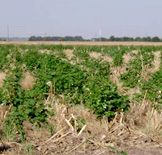Boll Weevil Eradication: A Complete Success
The National Boll Weevil Eradication Program ranks close to Eli Whitney's invention of the cotton gin as one of the greatest advancements ever for the U.S. cotton industry. This federal-state-grower cost share program has helped thousands of U.S. cotton growers become more competitive and has been a plus for the environment.

The boll weevil has been eradicated in the Southeast states Virginia, North Carolina, South Carolina, Georgia, and Florida. Likewise, the boll weevil has been eradicated from Alabama, Tennessee, Missouri, Arkansas and Mississippi. A small number of boll weevils were captured in Louisiana during 2009, and expectations are that 2010 will not have boll weevil captures in Louisiana. The Far West is now boll weevil free in the states of California, Arizona, Oklahoma, and New Mexico. Texas continues to move the boll weevil free line across the state as the eradication battle continues. The active battle zones in Texas have had setbacks resulting from weevils being carried by hurricane winds into areas that were nearly weevil free.Additionally, the warm climate and lack of killing freezes in some southern areas have presented new challenges in maintaining a non-hostable cotton status. Cotton plants along roadsides, fence rows, and other non-cropping areas can result from seed inadvertently dropped during harvest or dispersed by wind. The lack of a killing freeze for these plants results in nursery areas to maintain or increase boll weevil populations. Similarly, seed dropped in a cotton field at harvest may germinate the following year although the producer planted the field to corn. The result are numerous cotton fruit utilized by boll weevils for reproduction sites. During the fall of 2008, the Texas Boll Weevil Eradication Foundation TBWEF began “seek and destroy” efforts to remove non-crop cotton plants along roadsides, fence rows etc. Additionally, TBWEF began trapping “prior year cotton fields” during 2009 regardless of what current crop was planted. These efforts along with support and active assistance by producers to remove any “non-crop cotton plants” have advanced the eradication line.
History at a Glance
- A little more than a century ago, Anthonomus grandis (boll weevil) migrated from Mexico to the U.S. and spread rapidly throughout the Cotton Belt. Since then, it has cost America's cotton producers more than $15 billion - from yield losses and costs to control the insect pest.
- In 1958, the National Cotton Council officially recognized the economic havoc the boll weevil was wreaking on U.S. cotton production. With Congressional leadership and support, a USDA Boll Weevil Research Lab was created followed by eradication experiments, a trial eradication program and an areawide boll weevil control program on Texas' High Plains and Rolling Plains to prevent the weevil's migration.
- In the late 1970s, the National Boll Weevil Eradication Program was launched by USDA's Animal and Plant Health Inspection Service (APHIS) along the Virginia-North Carolina border.
- Grower referendums were initiated to continue the advancement of the Boll Weevil Eradication Program. Growers funds with some state support accounted for over 70 percent of the program operation budget with less than 30 percent of funds provided by Federal cost share.
- The program later expanded into other Southeastern states followed by southwestern Arizona, southern California and a portion of northwest Mexico. Later programs were launched in Oklahoma, New Mexico, the Mid-South, and Texas.

